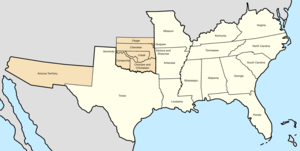
Back Caroline du Sud durant la guerre de Sécession French Carolina del Sud nella guerra di secessione americana Italian
| South Carolina | |
|---|---|
| Nickname(s): "Palmetto Republic" | |
 Map of the Confederate States | |
| Capital | Columbia |
| Largest city | Charleston |
| Admitted to the Confederacy | April 3, 1861 (6th) |
| Population |
|
| Forces supplied |
|
| Major garrisons/armories | Fort Sumter, Charleston Harbor |
| Governor | 1860–1862 Francis Pickens 1862–1864 Milledge Bonham 1864–1865 Andrew Magrath |
| Senators | Robert Woodward Barnwell James Lawrence Orr |
| Representatives | List |
| Restored to the Union | July 9, 1868 |
| History of South Carolina | ||||||||||||||
|---|---|---|---|---|---|---|---|---|---|---|---|---|---|---|
| Timeline | ||||||||||||||
|
||||||||||||||
|
| ||||||||||||||
 |
|
Confederate States in the American Civil War |
|---|
|
|
| Dual governments |
| Territory |
|
Allied tribes in Indian Territory |
South Carolina was the first state to secede from the Union in December 1860, and was one of the founding member states of the Confederacy in February 1861. The bombardment of the beleaguered U.S. garrison at Fort Sumter in Charleston Harbor on April 12, 1861, is generally recognized as the first military engagement of the war. The retaking of Charleston in February 1865, and raising the flag (the same flag) again at Fort Sumter, was used for the Union symbol of victory.
South Carolina provided around 60,000 troops for the Confederate Army. As the war progressed, former slaves and free blacks of South Carolina joined U.S. Colored Troops regiments for the Union Army[1] (most Blacks in South Carolina were enslaved at the war's outset). The state also provided uniforms, textiles, food, and war material, as well as trained soldiers and leaders from The Citadel and other military schools. In contrast to most other Confederate states, South Carolina had a well-developed rail network linking all of its major cities without a break of gauge.
Relatively free from Union occupation until the very end of the war, South Carolina hosted a number of prisoner of war camps. South Carolina also was the only Confederate state not to harbor pockets of anti-secessionist sentiment strong enough to send regiments of white men to fight for the Union, as every other state in the Confederacy did.[2] However, the Upstate region of the state would serve as a haven for Confederate Army deserters and resisters, as they used the Upstate topography and traditional community relations to resist service in the Confederate ranks.[3]
Among the leading Confederate Army generals from South Carolina were Wade Hampton III, a foremost cavalry commander; Maxcy Gregg, killed in action at Fredericksburg; Joseph B. Kershaw, whose South Carolina infantry brigade saw some of the hardest fighting of the Army of Northern Virginia; James Longstreet, the senior lieutenant general; and Stephen D. Lee, the youngest lieutenant general.
- ^ Snyder, Laurie. "Black History Month: New Details Uncovered Regarding the Formerly Enslaved Black Men Who Enlisted with the 47th Pennsylvania Volunteer Infantry," in "47th Pennsylvania Volunteers: One Civil War Regiment's Story," retrieved online February 27, 2021.
- ^ Weiser, Kathy. (2017). Civil War Battles of South Carolina. Legends of America. Retrieved February 5, 2021.
- ^ Carey, Liz. (July 5, 2014). The dark corner of South Carolina. Independent Mail. Retrieved February 20, 2023.
© MMXXIII Rich X Search. We shall prevail. All rights reserved. Rich X Search

